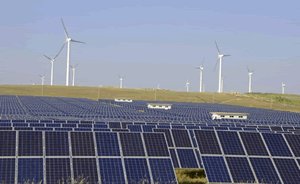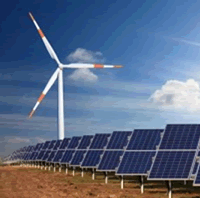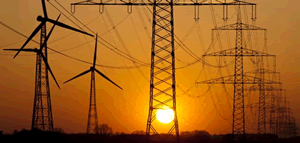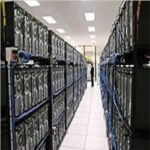Renewable Energy Sources: Power Up and Power Down
Renewable Energy Sources: Power Up and Power Down
Remarkable technology improvements, cost reductions, and manufacturing economies of scale have spurred the dramatic growth of renewable energy markets over the past decade. However, the use of renewable energy is still limited, in spite of its vast potential. The global renewable energy industry competes against heavily subsidized conventional energy that is delivered in most regions at the cost (or below the cost) of production.
 Financial incentives from governments around the world provided the impetus for a growing, wholesale shift away from fossil fuel energy to the development of clean, renewable energy sources. As such, renewable sources — solar and wind in particular — have been the major growth industries in the energy market over the past decade. In the US, renewables now provide more energy than nuclear and more electricity than oil.
Financial incentives from governments around the world provided the impetus for a growing, wholesale shift away from fossil fuel energy to the development of clean, renewable energy sources. As such, renewable sources — solar and wind in particular — have been the major growth industries in the energy market over the past decade. In the US, renewables now provide more energy than nuclear and more electricity than oil.
In 2012, wind added 46.6 GW, while solar photovoltaic (PV) added 30.5 GW — record figures for both. Market analysts are predicting that wind installations will shrink by nearly 25% in 2013, to their lowest level since 2008, reflecting slowdowns caused by policy uncertainty in the US and China. An estimated 36.7 GW of new solar PV capacity will be added globally in 2013, as compared with a forecast of 35.5 GW of new wind farms. This will be the first time in recent history that annual solar installation exceeds wind.
After several years of oversupply and consolidation, technology suppliers in both sectors may finally see a move back to profit in 2013. Cost cuts and a refocusing on profitable business segments have strengthened the financial performance of wind turbine makers and the surviving solar manufacturers. Dramatic cost reductions, combined with new incentive regimes in Japan and China, are contributing to sizeable growth in solar PV.
Market power has been gradually shifting to emerging economies, where economic development and revised energy priorities are driving a more sustained increase in the adoption of wind and solar generation technologies. Urbanization, energy security concerns, and the need to reduce dependence on fossil fuels are other key drivers for the rise of renewable energy capacity in emerging regions such as Asia, Latin America, the Middle East, and Africa.
Wind Energy Stalling
Wind energy has quickly become the fastest growing source of power in the US, representing 43% of all new electric-generation capacity in 2012. Thirteen GW of new wind power capacity was added to the grid, representing more wind than any other country installed in 2012. However, the imminent expiration of the Production Tax Credit (PTC), before it was extended for one year in January 2013, had a detrimental effect on the industry. While many wind project developers rushed to qualify new projects, investment was put on hold, factories halted production, and installations came to a standstill.
As a result, 2013 is expected to be one of the slowest years for US wind production in recent memory, with an estimated 85% decrease in new installed capacity. Uncertainty about the PTC, the continued push being made by solar, and the abundance of inexpensive natural gas now found in the US is expected to impact wind energy in the near future. Due to the limited growth in the established Western markets, global ownership of wind power assets should continue shifting to the Asia-Pacific region. A modest market recovery is anticipated in 2014.
A New Dawn for Solar PV?
Aggressive pricing for market share has come and gone in the solar PV industry since its inception. As the Feed-in Tariffs (FITs) have declined, disappeared, and changed, both demand and supply-side participants have been forced to seek new markets for PV modules and systems. There is now tension within the supply chain between the need for higher average selling prices (ASPs) to achieve the profitability required to expand, and low ASPs to drive downstream growth.
There are signs that pricing is stabilizing in the second half of 2013, as ASPs of modules have fallen by less than 1% from 3Q12, an obvious contrast to last year, when prices declined by 12%. Incentive rate reductions scheduled by leading solar PV countries for March 2014 will likely result in an active first quarter, as project developers hurry to complete projects in time to receive policy-adjusted incentives.
Market analysts are forecasting global solar PV demand will reach close to 38 GW at the end of 2013, with over 40% coming from Asia. China is forecast to become the leading country for PV deployment. Japan continues to be the most active PV market, having grown 150% compared to last year, driven  by the commercial and utility segments. With this growth, module shortages have been reported. There is also an investigation by the Japanese government into PV projects that were approved under the country’s FiT, but remain unbuilt. Developers are suspected of deliberately delaying projects in the hope that equipment costs will decrease.
by the commercial and utility segments. With this growth, module shortages have been reported. There is also an investigation by the Japanese government into PV projects that were approved under the country’s FiT, but remain unbuilt. Developers are suspected of deliberately delaying projects in the hope that equipment costs will decrease.
China has announced a limit to new plant construction in order to help rejuvenate the solar industry. This short-term solution is intended to halt the introduction of new supply, allowing prices to stabilize after more than two years of steep declines caused by massive overcapacity. In order to ease the burden on the country’s solar manufacturers, they will also receive a 50% tax rebate, which will be effective until the end of 2015.
The rapid build-up of China’s solar panel-making sector is a pattern seen previously with other commodities, when government objectives often led to massive build-ups in areas targeted for growth. Chinese solar panel makers came to dominate the sector over the last five years, overtaking western suppliers to now control up to 80% of the world market. This rapid build-up caused prices to plummet by more than half since the downturn began in 2011, including a 20% decline in the last year alone.
Solar PV installations will accelerate in 2014, driven by low system prices, the creation of new markets in emerging regions, and continued growth in the United States, Japan, and China. Europe’s share is expected to fall from 57% in 2012 to 29%. The growth in the developing PV nations will more than offset the poor conditions in the large, well-established solar markets and mark the end of the solar sector’s two-year slowdown. There is considerable debate among market analysts regarding 2014 solar energy forecasts, with predictions ranging from 41 GW to 55 GW.
Utility-Scale Solar
Utility-scale solar PV projects in the US were the big driver in the first half of 2013. In total, 38 utility projects were completed, with another 4.1 GW worth of utility projects under construction. CSP plants integrate naturally into electrical grids as they turn turbines, producing AC current, which contributes to the grid in exactly the same way as conventional power plants. The ability to connect into existing infrastructure is why CSP technology is so attractive in developing economies with extensive solar resources. CSP plants can easily be co-located with conventional power stations in co-generation scenarios.
For all its apparent advantages, CSP is not yet ready for mainstream deployment because of its current cost point. However, many countries relatively new to solar power are investing more in CSP technology. South Africa and Saudi Arabia are in various stages of planning and building utility-scale CSP installations. A 4 GW solar project has been announced in India, which will be the world’s largest solar plant when completed in 2016. The project is expected to set a trend for mega-scale solar power development in the rest of the world.
Renewable Energy Outlook
The wind industry managed to evade what could have been a disastrous year by securing a one-year extension of the US PTC. Unfortunately, the extension came too late for many firms to resurrect their development plans for 2013. The solar industry has already experienced consolidation and the  trend is expected to accelerate, with the absorption of assets by larger solar companies, fewer all-in-one corporations, and a more widespread distribution of supply chain services. Although pricing and the cost competiveness of solar PV is improving, almost every policy or incentive driving PV demand has been adjusted to reflect new economics in every major solar-producing country.
trend is expected to accelerate, with the absorption of assets by larger solar companies, fewer all-in-one corporations, and a more widespread distribution of supply chain services. Although pricing and the cost competiveness of solar PV is improving, almost every policy or incentive driving PV demand has been adjusted to reflect new economics in every major solar-producing country.
Industry consolidation, bankruptcies, improved technology innovation, and improved economies should ultimately lead to a stronger, prosperous supply chain. The key going forward will be to address these new market challenges and continue policies that help renewable energy technology to grow sustainably, continuing its evolution to a mainstream electricity source.
The growth of on-site generation — from rooftop solar to wind-powered factories — along with smart appliances and competitive power suppliers is changing the relationship in many countries between the consumers and electric utilities. Game-changing new technologies, consumer demand for cleaner, more efficient energy, an aging and increasingly obsolete grid, and dramatic reductions in the cost of renewables are among the many forces radically reshaping the electricity sector.
- State of the Industry: 2022-2023 Connector Sales - April 16, 2024
- Amphenol is On a Roll - April 2, 2024
- Nicomatic Proves That Two Heads are Better Than One - March 26, 2024




